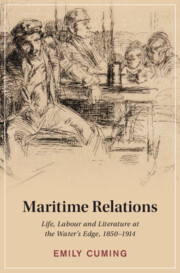Refine search
Actions for selected content:
17 results
Chapter 2 - Logbooks
-
- Book:
- Maritime Relations
- Published online:
- 23 August 2025
- Print publication:
- 04 September 2025, pp 60-100
-
- Chapter
- Export citation
Conclusion
-
- Book:
- Maritime Relations
- Published online:
- 23 August 2025
- Print publication:
- 04 September 2025, pp 182-186
-
- Chapter
- Export citation
Introduction
-
- Book:
- Maritime Relations
- Published online:
- 23 August 2025
- Print publication:
- 04 September 2025, pp 1-17
-
- Chapter
-
- You have access
- HTML
- Export citation
2 - Telegraphy as Social Lubricant
-
- Book:
- Love, Class and Empire
- Published online:
- 10 July 2025
- Print publication:
- 04 September 2025, pp 42-69
-
- Chapter
- Export citation

Maritime Relations
- Life, Labour and Literature at the Water's Edge, 1850–1914
-
- Published online:
- 23 August 2025
- Print publication:
- 04 September 2025
Chapter 2 - Betweenness
-
- Book:
- Embodiment in Nineteenth-Century American Literature
- Published online:
- 29 June 2025
- Print publication:
- 17 July 2025, pp 55-82
-
- Chapter
- Export citation
1 - Holywell Street Medicine
-
- Book:
- Selling Sexual Knowledge
- Published online:
- 24 June 2025
- Print publication:
- 10 July 2025, pp 22-56
-
- Chapter
-
- You have access
- Open access
- HTML
- Export citation
Chapter 35 - Seriality
- from Part VI - Critical Understandings
-
-
- Book:
- Sean O'Casey in Context
- Published online:
- 23 June 2025
- Print publication:
- 10 July 2025, pp 383-392
-
- Chapter
- Export citation
Chapter 32 - The Autobiographies
- from Part V - Non-Theatrical Writings
-
-
- Book:
- Sean O'Casey in Context
- Published online:
- 23 June 2025
- Print publication:
- 10 July 2025, pp 353-362
-
- Chapter
- Export citation

Embodiment in Nineteenth-Century American Literature
-
- Published online:
- 29 June 2025
- Print publication:
- 17 July 2025
43 - “Flung out of space”
- from How to Recognize the Queer Past before (and during) the Advent of Medicalization
-
-
- Book:
- The Cambridge History of Queer American Literature
- Published online:
- 17 May 2024
- Print publication:
- 06 June 2024, pp 770-785
-
- Chapter
- Export citation
Introduction
-
- Book:
- Working-Class Raj
- Published online:
- 20 October 2023
- Print publication:
- 02 November 2023, pp 1-23
-
- Chapter
- Export citation
6 - Fragmented Families
-
- Book:
- Working-Class Raj
- Published online:
- 20 October 2023
- Print publication:
- 02 November 2023, pp 149-167
-
- Chapter
- Export citation
2 - Writing Family Together across Imperial Distances
-
- Book:
- Working-Class Raj
- Published online:
- 20 October 2023
- Print publication:
- 02 November 2023, pp 49-69
-
- Chapter
- Export citation
8 - Cowboys on a Beach
- from Part II - Codes of Conduct
-
-
- Book:
- Whose Country Music?
- Published online:
- 03 February 2023
- Print publication:
- 01 December 2022, pp 116-130
-
- Chapter
- Export citation
5 - A Poor Woman’s Court of Justice, 1882–1910
-
- Book:
- Armed with Sword and Scales
- Published online:
- 05 February 2021
- Print publication:
- 04 February 2021, pp 218-280
-
- Chapter
- Export citation
Introduction: Warrior Heroes and Sexual Conquerors
-
- Book:
- Pulp Vietnam
- Published online:
- 22 October 2020
- Print publication:
- 22 October 2020, pp 1-27
-
- Chapter
-
- You have access
- HTML
- Export citation
